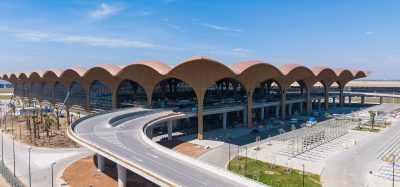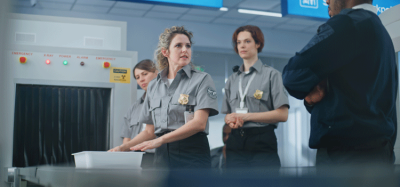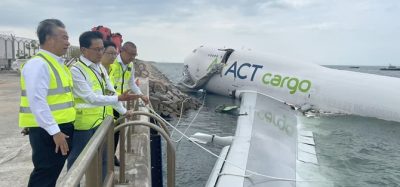Better planning for emergencies
Posted: 25 November 2005 | John Goglia, Professor of Aviation Science, Saint Louis University | No comments yet
John Goglia reports from his unique perspective on the outcomes of Operation Atlas, the largest drill conducted in the world to date designed to show how airport and security forces cope with a terror attack.
John Goglia reports from his unique perspective on the outcomes of Operation Atlas, the largest drill conducted in the world to date designed to show how airport and security forces cope with a terror attack.
Many of us who have spent more than half a decade in aviation have seen our lives and routines changed dramatically since aviation became a tool for terrorists, who use the visibility of aviation to get the publicity they desperately seek. The years of terrorist activity in the Middle East have clearly demonstrated that innocent lives mean very little to them. However, our passengers do mean a great deal to all of us who call aviation our business and our livelihood. Because of that we go to great lengths to make the travelling experience as safe and enjoyable as possible.
The process that begins from the point of entrance to the airport and completes when an aircraft takes off is a complex and intergraded one. This process is also repeated when the aircraft lands. In order for our passengers to feel safe and comfortable, we must ensure that all the varied efforts in the process occur seamlessly. This is not necessarily an easy task, but it is one that we have been able to master thanks to many years of effort.
Join us live: Shaping the Next Generation of Hold Baggage and Air Cargo Screening
Join us live for an insightful webinar on 11th December at 14:00 GMT, in collaboration with Smiths Detection, as we explore the strategic balance of operational efficiency, regulatory compliance, and sustainability in high-volume security environments.
This session offers a focused look into future-proofing your security strategy.
Key learning points
- Cost Reduction: Strategies to minimize bag travel time while simultaneously reducing operational costs.
- Regulatory Roadmap: Insights into the next wave of regulatory changes and their impact on future investment decisions.
- Sustainable Systems: Practical approaches to building sustainability into security systems and lowering the total cost of ownership (TCO).
- Scalable Solutions: Real-world examples of scalable systems supporting current airport growth and preparing for tomorrow.
Register now for expert insights, case studies, and actionable strategies on operational efficiency!
Today, there is a new and fully intergraded member of our team; a full range of law enforcement and a number of national intelligence agencies. Not only are they new, but they are also a large and growing member, and have certainly complicated the task of passenger handling.
One of the ways that we deal with the problem of increased complication is to conduct exercises to practice our procedures. These help to discover how procedures work and how well they work in tandem with procedures developed by other airport related agencies.
In the United States, the FAA has long required that an airport fire rescue organisation is able to demonstrate their ability to respond to any aircraft emergency within specific time parameters. Since September 11, 2001 these demonstrations, called drills, have been expanded by many airports to include the full range of security issues, engaging many of the organisations that would be required to participate in a real emergency.
A few months ago I was able to participate, as an observer, in the largest of this type of exercise to date in Boston, Massachusetts. It involved more than 50 aviation emergency response and law enforcement organisations. The goals of this exercise were simply to help further develop the communication and coordination of all the agencies involved. These simple goals proved to be a challenge to capture, accurately record and develop improvements.
Drill for safety
In order to have a successful exercise you must have a very detailed and well thought-out plan. In the experience of Boston developing such a plan required a considerable time and resource effort; given the fact that so many organisations were involved. Several months were therefore spent developing a realistic scenario that would encompass every group. The exercise was given the name of OPERATION ATLAS.
Early in the planning process we had a commitment from a major airline for the use of an aircraft which added a great deal of credibility to the exercise. We wanted to test the communications from an aircraft in flight and the agencies on the ground as part of the scenario. Law enforcement also wanted to test their procedure for regaining control of an aircraft taken over by terrorists, so that was included. The airline also wanted to test their procedures for communication and control of their aircraft when it is required to divert to an airport other than the one planned for its arrival.
Essentially, the same concerns were expressed by all the groups who were involved, including the political groups. The Governor’s office had their concerns, as did the Mayor of the City of Boston, so ways to activate their plans were worked into the exercise. The same process went on to include airport operations, the control and diversion of private motor vehicles entering the airport, passenger control (including meeters and greeters), and those who would come to the airport to see what was going on (and in most cases add to the problem of crowd control). All of the area’s surrounding hospitals also wanted to exercise their disaster plans; for both transportation to the hospital as well as the intake of victims of a mass casualty event.
Major events that occur in an airport also affect the surrounding communities greatly, so their concerns were also included in the exercise. This included the ability to move emergency equipment, Police, Fire and transportation for the injured and deceased, into and out of the airport and onto their destinations without being caught up in massive traffic problems.
Design challenges
Even this is not all of what the team designing this exercise were faced with, but I hope you can understand from this description that the effort was very large and very detailed in order to maintain a high level of realism. The time line to accomplish all of the planning was about 6 months, with many small meetings and mini tabletop exercises and five major tabletop exercises often involving more that 100 people. Early in the planning we were forced to conduct these sessions in large function halls.
As the date of the exercise was approaching we started to focus on how we were going to capture all that was to happen, with the complication of many elements occurring simultaneously. In many ways the collection of the maximum amount of information possible from the events around this exercise was as important as the exercise itself. The most obvious way to capture this information was to use multipliable video cameras to record the actions of every element involved. We did just that, but we were also aware that the camera angles could not always be correct, so we also used a number of trained observers to watch and record the old fashioned way, filling in the many expected gaps.
Operation Atlas
The day of the actual exercise started early, about 4am, with the briefing of the volunteers who were to represent the passengers on a normal flight. Soon many of the other groups started to arrive and prepare for their roles in the exercise. Before long it was time for the aircraft to depart. The plan had the aircraft fly east, away from Boston, then turn and return as if it was coming from Europe, simulating an attempted takeover of the aircraft and testing the communications between the aircraft, ATC, the airline ground center and the airport, including law enforcement.
This activity would result in the activation of the airport’s emergency operations center to coordinate communications between all the various agencies. The size of the exercise meant that many agencies would be sending representatives to the command center to simulate their communication links. After the aircraft landed the law enforcement personnel tested their procedures for this type of situation. Then it was the airport crash, fire, rescue team’s turn to test their procedures. This included dealing with a fire and the triage of injured passengers for transportation to the waiting medical facilities.
The largest numbers of personnel involved were with the law enforcement elements of this exercise, which numbered several hundreds of participants.
Given the expanding roll that law enforcement is playing in aviation, this was not a surprise. Boston also has a large number of hospitals, so the support necessary to move the injured was also well represented. I do not believe that many airports around the world would be as fortunate to have the number of medical facilities so close to the airport that Boston has. This certainly could be a big asset in a real emergency.
As I stated earlier, we started about 4 am and by 4pm we were finished. The folks who started early were finished first except for those involved in the planning and evaluations. I am sure that all had no problem sleeping that evening.
Results
So what was the outcome? We had some of what we expected and we had some unexpected disconnects.
With so many law enforcement agencies represented we were sure that we would have problems and we were not disappointed. Some of these agencies did not have an opportunity to interface previously under a near-real world set of circumstances. Communication was the first aspect to strain, partially because all the agencies had a cadre of representatives within the Emergency Operations Center (EOC). Simply stated, there were too many people and a large amount of noise as all tried to communicate with their teams.
Starting as the aircraft was about to land the coordination efforts increased, causing frantic efforts to maintain command and control. Much was learned by law enforcement agencies and a considerable effort has started to improve by using what was learned.
However, it wasn’t just law enforcement that experienced this problem. All the agencies had the same challenge, with some leaving the facility and controlling their organizations from their own command centers. The lesson here was that the EOC staffing should be kept to a minimum from each group, with support members in adjoining meeting rooms providing links to their agencies.
Datalinks
Another consideration was that the data feed capabilities were strained beyond their designed limits. Today, our ability to gather data grows so fast that it seems impossible to keep up, so real efforts must be made to ensure we collect only what we need, but still collect all of the data for future possible use. Some of this proved to be quite insightful, such as a link to the original destination for this flight, Chicago, which enabled family and friends to have real time information about their loved ones.
Real-time links to the airline’s three crisis centers also kept the information flowing in both directions. In fact the information obtained was often timelier than the law enforcement links that we were operating. Since the scenario involved passenger fatalities we also activated the Logan Airport family assistance plan. This provided assistance to both the passengers, and to all the employees and first responders who in a real event would also need help.
Logan Airport has certainly taken a leadership position when it comes to family assistance and I would encourage an airport authority to look at what they have accomplished.
One thing that I noticed that others did not was the demands on equipment that this type of event place on an airline. Two sets of stairs are needed as well as power units and an air-conditioning unit to provide airflow through the cabin. Also what do you do with a large number of passengers after the aircraft is unloaded?
Just providing transportation to the terminal can be a challenge if not planned for in advance.
At the end of the day we felt we were successful in conducting a very challenging exercise without any injuries and with the collection of data that will improve the process for the future. I believe that we in aviation care a great deal about our passengers and go the extra mile to make sure that we are prepared for these types of events.
John Goglia
A member of the US National Transportation Safety Board for nearly a decade, John joined the faculty of Saint Louis University in 2004. He now works at the University to create programs that address transportation safety and disaster prevention and preparation. In addition to the teaching, research and advising components of this role, John continues to pursue initiatives that address safety internationally. He also maintains an office in Washington, D.C., where he is widely noted as a tireless advocate for transportation safety.
Join our free webinar: Beyond silos: How ecosystem thinking elevates the airport experience
In today’s complex aviation landscape, airports are moving beyond siloed operations to embrace a new era of collaboration. This webinar focuses on how leading airports are using ecosystem thinking to adapt, personalize, and continuously improve every touchpoint, boosting both passenger satisfaction and non-aeronautical revenue.
Date: 13 Nov | Time: 10:00 GMT
REGISTER NOW TO SECURE YOUR SPOT
Can’t attend live? No worries – register to receive the recording post-event.


















